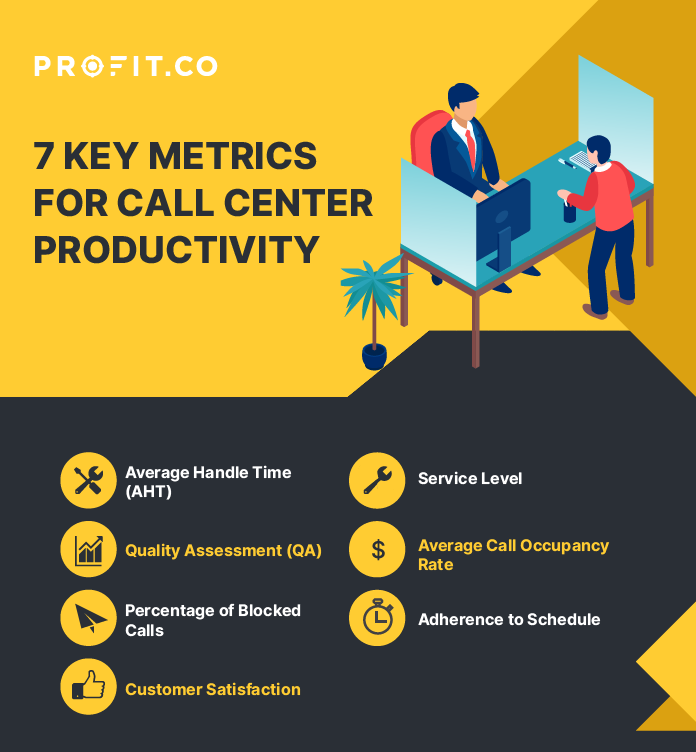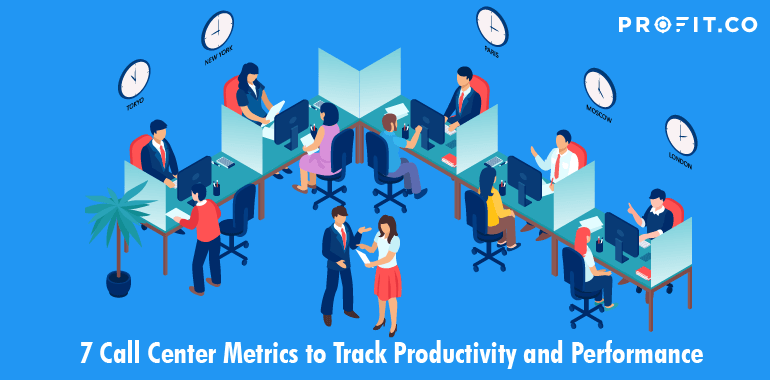Call center metrics evaluate the effectiveness of customer service teams. They help gauge the productivity and performance of your employees and compare progress to business goals.
Call centers often have a large inflow of data from platforms that manage various business processes. Metrics assist in monitoring this data and translating it to actionable insights.
The only purpose of customer service is to change feelings.
There are numerous call center metrics. Your choices depend on how you intend to use the data. For instance, team leaders in the call center will need different metrics than the executive managers.
Team leaders and operational managers need comprehensive metrics to make more informed decisions. Executive managers require more strategic KPIs and metrics to monitor business performance.
Let’s explore the top metrics you need to track productivity and performance.
Why Does Call Center Performance Matter?
According to a study completed in 2021, 74% of disengaged workers would readily leave their jobs for another opportunity. Low engagement at work has been linked to lower productivity, so it’s a good idea to monitor the most important metrics for your team.
Call centers can use various systems and tools to track progress and report performance. When identifying the essential call center metrics, it’s best to consider two things:
1. Whether the call center agent can control or adjust the metric
It’s essential for management teams to evaluate agents on metrics within their control. Sometimes metrics are affected by external factors such as incoming call traffic. In such a case, metrics such as the service level and average answering speed are misleading.
2. Whether pinning accountability of the metric on an agent will encourage behavior that affects the quality of service.
For instance, if you evaluate agents based on the AHT (Average Handle Time), they may rush through calls instead of addressing the customers’ issues.
7 Key Metrics to Help Your Team Track Productivity and Performance

As motivational speaker and author Jim Rohn writes, making a sale means you’re making a living. If you invest your time and good service in your customers, you’ll make a fortune. When selecting which metrics to use, balancing quality and productivity is essential.
1. Average Handle Time (AHT)
AHT evaluates productivity by measuring the time agents spend interacting with one customer. Over-emphasizing AHT can cause agents to leave many unresolved issues as they rush to close calls.
There are three components of AHT:
Average After-call Work Time
After-call work time refers to the duration an agent takes to perform additional tasks after finishing the call, such as updating the customer’s file.
This data helps you identify the areas, technologies, or processes that you can improve to minimize after-call work time. You can see what to automate to reduce the time agents are spending on task management.
Average Hold Time
Hold time refers to the time incoming calls remain on hold. By comparing the agent’s time with the average, you can see the agents who struggle. For instance, the agents may have challenges navigating various systems, keeping customers on hold for longer.
They may also be struggling with the details of a particular new product, so they take longer to research and relay the information.
Such information generates actionable insights such as the need for more training, simpler interfaces, and better resources.
Average Talk Time
Talk time refers to the time an agent spends speaking with one caller. The duration varies, but an average emerges with time.
Management teams need to monitor agents whose talk time abnormally differs from the team’s average. You can use call monitoring tools to pinpoint struggling agents. It’s easier to determine precisely where the issue is or the particular areas the agent finds challenging.
2. Quality Assessment (QA)
Quality assessment is when the management or quality assurance team evaluates agents’ phone calls. They score them based on various factors such as observing procedures and policies and the level of engagement.
The QA results help identify where agents require extra training, coaching, and feedback to reach optimum performance.
There are two vital aspects to monitor in quality assessment as a call center KPI: contact resolution and call control.
Call Control
The analyst should evaluate how the agent controlled the flow of conversation when assessing calls. They must balance quality and productivity because some issues take longer to address.
Well-controlled calls have lower AHTs and flow well, enhancing the overall efficiency.
First Contact Resolution (FCR)
Resolving the customer’s issue on the first contact is an essential call center KPI. It refers to the percentage of calls that agents manage to fully address the customer’s problem without escalating, transferring, or returning the call.
FCR often determines the customer’s satisfaction level and opinion about your brand.
You should also monitor whether the agent followed the protocol and procedure to resolve the issue to the best of their ability. Also, consider cases where the policies or procedures prevent the agent from offering full resolution.
Sometimes the customer needs to call back with more information, so it’s technically not the first contact resolution. However, the agent did everything correctly based on their ability.
3. Percentage of Blocked Calls
The percentage of declined calls is essential because it affects customer satisfaction. Getting a busy tone every time they call frustrates customers. It can because:
- There are no configured call queues, the queues are full, or there are no available agents
- The software used in the call center cannot accommodate the call volumes.
Every declined call is a missed chance to connect with a customer or potential customer. Determining the percentage helps you decide whether or not you should upgrade the system or hire additional agents.
You can calculate the percentage of blocked calls as a call center KPI using the formula:
4. Customer Satisfaction
There are various ways to determine customer satisfaction levels. Most call centers combine quality assessment results and customer surveys or feedback.
Customer satisfaction determines how efficient and effective your call center is. Ensure you focus the call center metrics on areas that agents can control or adjust, such as effectiveness, tone, and politeness.
You can also break customer satisfaction scores into specific categories, such as the call type. It’s an excellent way to pinpoint the problem areas that require additional training quickly.
5. Service Level
In a call center, the service level is the number of calls you handle within a specific time. It’s an essential KPI for a call center that ensures you deliver consistent customer service levels.
According to industry standards, the ideal service level is 80/20. This means you should answer 80% of incoming calls within 20 seconds.
Assessing your service level provides you with actionable insights to enhance performance. Fluctuating levels indicate internal issues that you need to address.
You can use this formula to calculate your service level:
6. Average Call Occupancy Rate
The call occupancy rate measures the agent’s efficiency and work pace. Higher occupancy rates indicate there’s less time lost between calls. However, expecting a 100% occupancy rate as a KPI for call centers is unrealistic. You’ll end up with higher burnout levels.
The ideal occupancy rate is between 85% and 90%, so ensure you set realistic targets. This data helps you determine whether you’re utilizing your workforce well before hiring more agents.
7. Adherence to Schedule
Adherence to schedule measures when an agent is available, logged in or attending to customers. This also includes their time on unnecessary outbound calls and after-call work.
When measuring schedule adherence, avoid including training, lunch, and breaks. Although agents have no control over the number of calls or AHT in some cases, they are accountable for their actions and time.
However, overly stringent measures and micromanagement does more harm than good. You can try some tips to improve, such as:
- Training all agents on how they affect the call queues, accessibility to customers, and satisfaction levels
- Setting realistic response time and service level targets that all team members understand and agree with
- Relaying real-time information to the agents and following it up with relevant training to help them interpret the data
- Monitoring schedule adherence to create effective processes at the workplace
Conclusion
The call center metrics you use directly affect the customer experience. Besides productivity metrics, you should also consider the business goals and operational costs.
Ensure you balance these metrics to enhance performance without sacrificing customer satisfaction. The metrics you select will show whether your agents resolve issues cost-effectively.
Ensure you follow up the assessment with relevant training to address the weak areas and gaps for optimum performance. Additionally, ensure that you track all your KPIs and call center metrics on a transparent platform so that all team members can see progress and monitor their productivity. Profit.co enables users to create custom KPI boards so they can get an at-a-glance look at their most important metrics and get the pulse of productivity and performance in the business.
You can get started on Profit.co completely free today, or you can schedule a free demo with our experts to learn more about how Profit.co can help you focus on your priorities, measure your progress, and achieve your goals!

